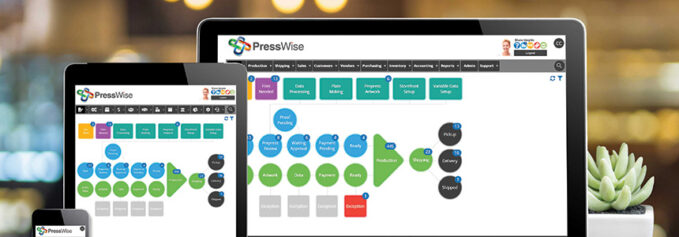
by Cassandra Balentine
When it comes to managing business information, print service providers (PSPs) rely on some form of print management information systems (MIS), whether it is a proprietary system, an end-to-end software solution, or various tools that ideally integrate and communicate with one another.
“With the amount of information required for one simple job—from estimating to proofing and payments, it’s not possible to stay competitive and profitable without an efficient print MIS,” explains Adam Witek, VP of operations, Print Reach.
“All shops are using some kind of tool to manage their business information,” agrees Matt Prusa, director of sales, software and strategic solutions, Avanti and Print MIS, Ricoh U.S.A. These tools can be homegrown. For example, using Microsoft Excel to create estimates or compile a list of open orders. “However, 35 percent of all printers use email to manage orders, which can sometimes result in lost or missed details, slowing down the production and fulfillment process.”
With MIS, print providers offer consistent pricing internally and online to customer-facing portals, track jobs within the shop, and determine which are most profitable. MIS has evolved in many aspects and print providers should consider whether or not it makes sense to evaluate if it’s time for a change.
“We speak regularly with companies who either need a managed solution or are not happy with their current solution,” notes David Graves, sales and marketing manager, Aleyant.
Many processes are often disparate and therefore unable to scale or track jobs and data efficiently.
An investment in print MIS helps to streamline these processes. “Most use disparate systems that are siloed and do not communicate with each other like a true MIS would allow, so they are frustrating to use,” admits Jack J Lafler, VP sales/technical services, HiFlow.
True print MIS does not work in isolation and is often tightly integrated with artwork systems, email, shipping, ecommerce, epayment, and other office applications. “It’s hard to get a single provider who can do it all,” offers Gerald Clement, partner, Computer Productivity Services Inc.
For those with an MIS in place, it is almost always underutilized. “In other words, all departments are not taking advantage of the time and labor saving features a print MIS offers,” says Prusa.
Another challenge comes with personnell. He adds that initial training with some members of the team may not be passed along to other members. When that employee leaves, the knowledge is lost.
Cloud-Based
The shift to cloud-based workflows is apparent, however for many the decision to move critical business information to the cloud comes with concern in terms of giving up control and security.
Experts point to advantages. For example, cloud-based options have a propensity to help print providers build long-term partnerships with customers. “Working in the cloud we can deploy updates and enhancements organically with greater efficiency to our customers,” explains Tony Tarpey, CEO, PressWise. Lead time for response times as well as enhancement requests are shorter. “We are able to be nimble and scale our business as we need to,” explains Tony Tarpey, CEO, PressWise.
Users may also find upfront costs lower with a SaaS model, as most eliminate upgrade fees when a new version is released, “so customers always have access to the latest tools and features,” adds Tarpey.
Finally, browser-based solutions allow access from any place, any time. “The ability to engage with the print MIS from anywhere and at any time allows sales teams to meet with clients and provide immediate and accurate pricing and projected delivery times. With a cloud-based system there is no waiting to return to the office to translate scribbled notes into the client database. This client-centered responsiveness improves marketing efforts and increases new client acquisitions,” says Witek.
For those with multiple locations, a modern MIS allows each location to have a bird’s eye view of exactly what is happening with a job at any given time. “Having a cloud-based MIS allows companies to grow and to be profitable, which allows for higher volumes. If a company is specialized in a particular segment, this can enable a targeted approach without about internal labor or licensing issues,” shares Graves.
There are some doubts about the cloud, but many concerns have been addressed
Witek points out that some print providers are concerned their data won’t be secure, not realizing that you can back up the data on your own.
Lafler understands why many companies still do not have a 100 percent trust in cloud security. “Companies who retain an IT person or staff feel their data is much safer when it is inside a firewall in their control on a server,” he observes.
Vikash Bardia, sales director, PrintPLANR, also sees concern about the limited control over the software on the client end and unconfident networks or regions with less or no internet access.
Some also think it’s too expensive. However, when considering it’s the brains of your business, Witek feels that the true cost of not implementing a cloud MIS are not considered.
“The perceived limitation is not being in control and loss of business due to the service being down. Actually, having a cloud-based solution allows for better control, updated software, and less downtime,” comments Graves.
The anywhere, anytime advantage also has a flip side. “A cloud-based system requires an internet connection to access data and applications so if you have a weak or unstable internet connection, it could impact your ability to use the system,” admits Keith McMurtrie, CEO, Tharstern.
MIS Evolution
Print MIS solutions have evolved to offer interconnected, browser-accessible solutions that enable transparency.
Mar2023, DPS Magazine



